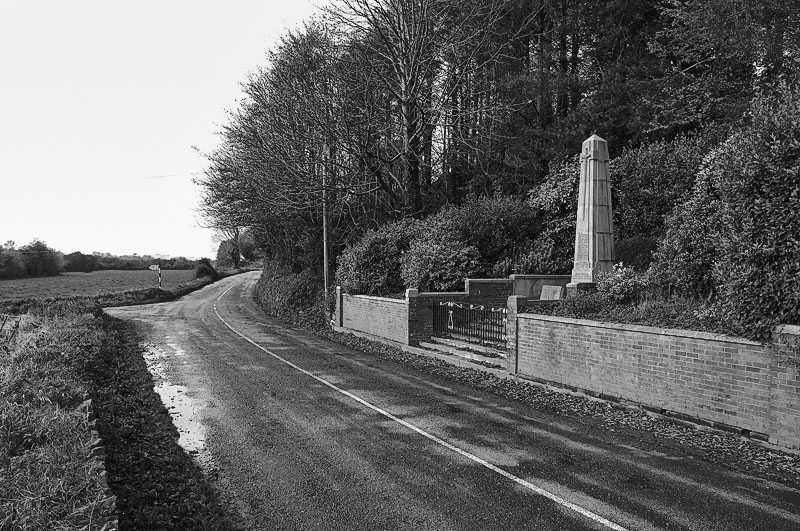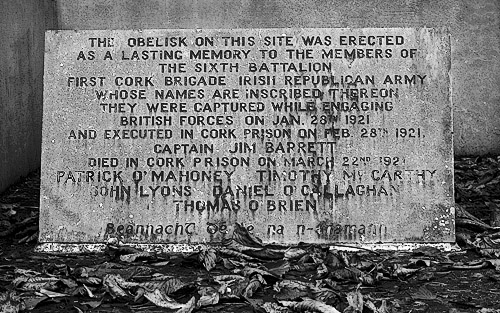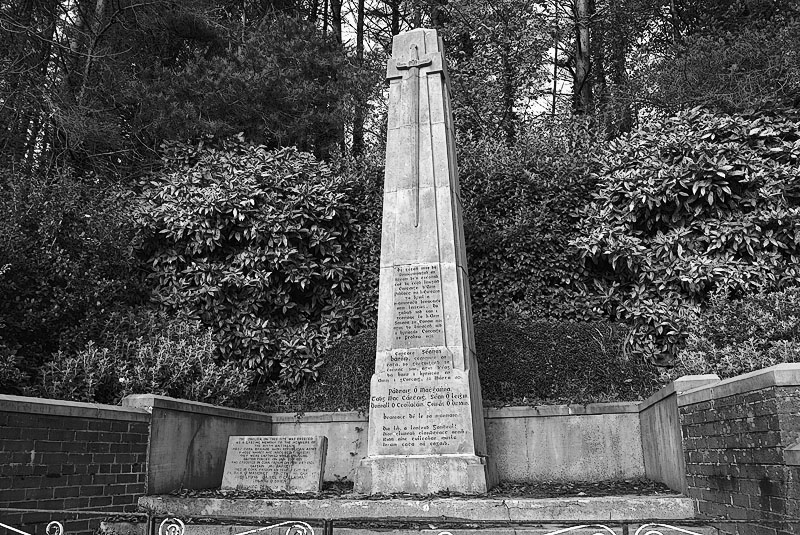Capture of I.R.A. Volunteers at Dripsey
The monument at the site of the attempted ambush at Godfrey's Cross where eight IRA volunteers were captured. Five were executed and another died of his wounds.
On the morning of January 28th. 1921, in an area known as Godfrey's Cross, located about half way between the villages of Coachford and Dripsey, an IRA ambush party of men from the 6th Battalion Cork No. 1 Brigade lay in wait for a convoy of British troops that regularly used this road when travelling between Ballincollig Barracks and Macroom.
News that the IRA was preparing for action soon became common knowledge amongst the local population. One resident of the area, who lived just outside the village of Coachford at Leemont House, was Mrs Mary Lindsay, a woman with strong Loyalist convictions. Upon hearing of the IRA's preparations, she travelled to the military barracks at Ballincollig and informed the British authorities of what she knew.
The barracks in Ballincollig was occupied by troops from the 1st Battalion of the Manchester Regiment. Their commanding officer, Colonel Dowling, decided to launch an attack against the IRA. At around 3.30p.m. a column of British troops under the command of Lieutenant-Colonel Garret Evans left the barracks for Dripsey village. At Dripsey the troops dismounted from their lorries, divided into five groups and set out to surround the ambush party. The IRA had scouts posted and one of these saw the approaching troops and alerted his comrades. The officer in charge of the ambush ordered a withdrawal, but firing soon broke out. Eight members of the IRA (five of whom were wounded) and two civilians were captured and brought to Ballincollig barracks. Two of the more seriously wounded IRA men were subsequently moved to the military hospital in Victoria Barracks. The others were later transferred to the military detention barracks in Cork where they awaited trial by military court.

The road between Dripsey and Coachford where IRA volunteers had laid in wait to ambush a convoy of British troops based at Ballincollig barracks.
On 8th. February the trial of eight of the ten men captured at Dripsey opened in the gymnasium of the military detention barracks (two others - Captain James Barrett and Volunteer Denis Murphy - were still being detained in the military hospital). As a matter of principle, Republicans who were captured and brought to trial refused to recognise or acknowledge British courts and claimed that they, as citizens of the Irish Republic, were only subject to laws that were passed by Dail Eireann. On this occasion, as the defendants would be liable to suffer the death penalty, brigade headquarters decided to test the legality of the military courts and sanctioned the appointment of defence counsel for the men. The defendants were;
Volunteers Thomas O'Brien, Patrick O'Mahoney, Timothy McCarthy, John Lyons, Jeremiah O'Callaghan and Daniel O'Callaghan, Eugene Langtry (civilian) and Denis Sheehan (civilian).
The military court consisted of a colonel and two majors of the British army. When the trial opened, the accused pleaded not guilty to the charges. The proceedings lasted two days. Volunteer Jeremiah O'Callaghan together with Eugene Langtry and Denis Sheehan, both of whom had no connection with the IRA, were found not guilty and released. The remaining defendants were found guilty and sentenced to death.
Of the two men still detained in the military hospital, Captain James Barrett died while still a prisoner on 22 March 1922. Volunteer Denis Murphy stood trial in Victoria Barracks on 9 March. He was found guilty and sentenced to death, but this sentence was later commuted to one of 25 years' imprisonment.
The IRA had discovered that Mrs Lindsay was the person who had supplied the military authorities with information about the ambush and, following the sentencing of the men involved in that operation, they decided on a course of action that they hoped would prevent the executions taking place. On 17 February the IRA surrounded Leemont House and abducted Mrs Lindsay and James Clarke, who was employed as her servant. On the evening of Saturday 26 February Volunteer Michael Ingerton, an IRA dispatch rider who still had the appearance of teenager, cycled past the residence of General Strickland outside Victoria Barracks and, while doing so, dropped an envelope from his pocket. One of the two sentries on duty outside the general's house noticed the envelope fall to the ground and went to retrieve it in order to return it to its owner. On reaching the envelope he noticed that it was address to 'General Strickland, Victoria Barracks'. The man who had delivered it had cycled out of sight. In the envelope was a letter from Mrs Lindsay which read:
Dear Sir Peter,
I have just heard that some of the prisoners taken at Dripsey are to be executed on Monday and I write to get you to use your influence to prevent this taking place and try and reprieve them - I am a prisoner as I am sure you will know and I have been told that it will be a very serious matter for me if these men are executed. I have been told that my life will be forfeited for theirs as they believe that I was the direct cause of their capture. I implore you to spare these men for my sake.
Yours very truly,
M. Lindsay.
A covering letter was attached to Mrs Lindsay's correspondence:
To General Strickland,
Sixth Battalion Headquarters,
Sixth Southern Division,
Victoria Barracks, Cork.
We are holding Mrs Mary Lindsay and her Chauffeur, James Clarke as hostages. They have been convicted of spying and are under sentence of death. If the five of our men taken at Dripsey are executed on Monday morning as announced by your office, the two hostages will be shot.
Irish Republican Army
On receiving the letters General Strickland discussed the situation with General Sir Neville Macready, who was the commander-in-chief of British forces in Ireland. Both men doubted that the IRA would go so far as to execute a woman and decided that the executions should proceed.
Early on the morning of 28 February, a large crowd gathered outside the gates of the military detention barracks where the widow of Tomas MacCurtain had erected an altar to pray for those who were about to die. At eight o'clock a volley of shots rang out from inside the barrack walls. As the crowds outside the barracks slowly began to disperse more firing was heard at eight fifteen and at half-past eight. Rather than execute the men all at once, the military authorities had decided to execute them at intervals of fifteen minutes.
On the night of the executions the IRA launched a number of attacks against British forces at different locations throughout Cork city, which resulted in six British soldiers being killed and four being wounded. Following the trial of Volunteer Denis Murphy on 9 March Mrs Lindsay and her servant James Clarke were executed by the IRA.







